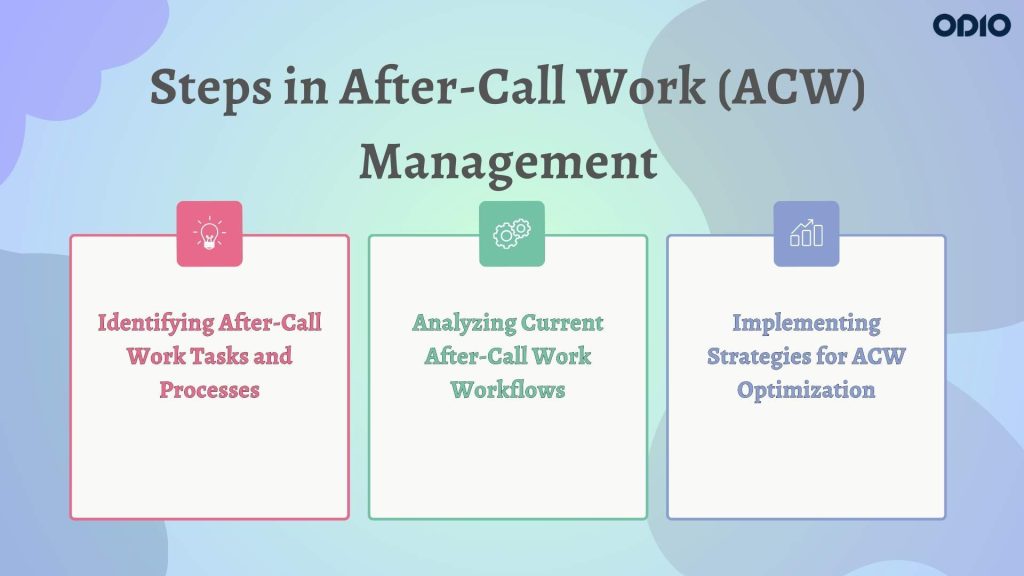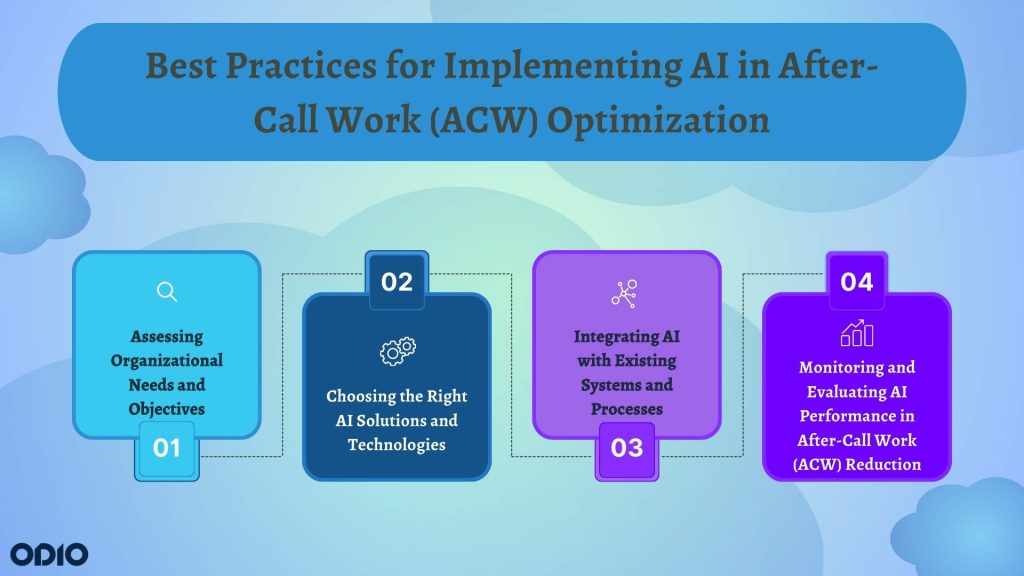
Every second matters in the hectic world of customer service. What occurs next after a customer conversation concludes can have a big impact on customer satisfaction and agent productivity. How agents spend their time immediately after a call ends can greatly influence. This time, known as After Call Work (ACW), is a vital yet often overlooked part of call center operations that plays a key role in shaping the customer experience and how customers interact with businesses.
What is After Call Work (ACW)?
Once a client engagement is over, call center agents engage in a variety of jobs and activities known as After Call Work. Updating records, documenting, Initiating follow-up actions, and getting ready for the next contact are usually included in these duties. After Call Work’s components can change based on the type of call and organizational needs, but they usually include data input, CRM updates, problem solving, and post-call analysis.
Common Tasks Involved in After Call Work (ACW)
During After Call Work, agents often complete several common tasks to facilitate smooth customer service, including updating customer records, logging call details, resolving issues raised on the call, scheduling follow-ups, and preparing relevant documentation. Completing these key tasks helps ensure customer information remains accurate, necessary follow-ups happen promptly, and overall service delivery stays seamless.
Impact of After Call Work (ACW) on Agent Productivity and Customer Experience
After Call Work duration directly influences agent productivity and, consequently, customer experience. Lengthy ACW periods can decrease agent availability for handling new inquiries, leading to longer wait times and reduced responsiveness. Moreover, inefficient ACW processes may result in inaccuracies or delays in customer information updates, impacting service quality and customer satisfaction levels.
Why After-Call Work (ACW) Is Important in Call Centers?
When it comes to call center operations, managing after-call work (ACW) time is crucial for delivering top-notch customer service and agent productivity. By optimizing ACW, call centers can enhance efficiency, bolster agent performance, and provide customers with a satisfying experience.
Enhancing Agent Productivity and Satisfaction
After Call Work management directly impacts agent productivity by streamlining post-call processes, thereby maximizing their availability for handling new inquiries. Efficient ACW workflows enable agents to swiftly transition from one interaction to the next, minimizing idle time and enhancing overall productivity levels. Moreover, by automating repetitive ACW tasks, agents can focus on high-value activities, leading to increased job satisfaction and reduced burnout rates.
Improving Customer Service Efficiency and Effectiveness
Improved efficiency and efficacy of customer service are directly correlated with successful ACW management. Call center representatives may provide rapid, individualized responses to consumer inquiries by handling post-call duties including updating client information and starting follow-up actions right away. Shorter handling times, quicker issue resolution, and ultimately higher service quality are all facilitated by shorter ACW durations.
Influence on Customer Experience and Loyalty
Long-term loyalty and the customer experience journey are greatly influenced by After Call Work optimization. Reducing ACW times guarantees quick response times and smooth transitions between conversations, making a good first impression on clients. Call centers may increase customer satisfaction and build enduring connections with their clients by acting professionally and promptly.
Steps in After-Call Work (ACW) Management
A strategic approach focused on optimizing operational efficiency and reducing after-call procedures is necessary for effective ACW management. Let’s explore the key steps for effective ACW management:

1) Identifying After-Call Work Tasks and Processes
The identification and classification of the tasks and procedures involved in post-call activities is the initial stage in After Call Work management. This entails recording every action that agents take following up with a customer, including creating reports, updating CRM systems, and setting up follow-up procedures. Through obtaining a thorough comprehension of ACW duties, call centers are able to create focused optimization techniques.
2) Analyzing Current After-Call Work Workflows
Following the identification of After Call Work tasks, current processes are examined to find any bottlenecks, inefficiencies, and potential improvement areas. Call centers can identify frequent pain points that impede ACW efficiency, such as redundant operations or manual data entry duties, by conducting a thorough investigation. Organizations can obtain useful insights into ACW durations and pinpoint optimization possibilities by utilizing call center analytics tools and performance indicators.
3) Implementing Strategies for ACW Optimization
After gaining knowledge from workflow analysis, call centers might employ focused tactics to enhance After Call Work procedures. This could entail incorporating AI technologies to expedite post-call processes or using ACW automation solutions to automate repetitive tasks. Standardizing processes and teaching agents effective ACW techniques can also help to increase productivity and shorten ACW times.
Benefits of Tracking After Call Work (ACW)
Tracking After Call Work provides valuable insights into call center operations, enabling organizations to make data-driven decisions and drive continuous improvement. Let’s explore the key benefits of tracking ACW and leveraging data analytics in optimizing post-call processes:
Providing Insights into Time Allocation
Tracking After Call Work allows call centers to gain visibility into how agents allocate their time after concluding customer interactions. By analyzing ACW durations and identifying time-consuming tasks, organizations can optimize resource allocation and ensure that agents prioritize high-value activities. This insight enables call centers to maximize agent productivity and minimize idle time, ultimately improving overall call center efficiency.
Identifying Areas for Improvement and Optimization
By monitoring ACW metrics and performance indicators, call centers can identify areas for improvement and optimization within their post-call workflows. Whether it’s streamlining manual processes, implementing automation solutions, or providing additional training and support to agents, tracking ACW enables organizations to pinpoint specific areas where interventions are needed to enhance efficiency and productivity.
Facilitating Performance Evaluation and Goal Setting
Tracking ACW metrics facilitates performance evaluation and goal setting for individual agents and teams. By establishing benchmarks and targets for ACW durations, call centers can set clear performance expectations and monitor progress over time. This data-driven approach to performance management enables organizations to recognize top performers, identify coaching opportunities, and drive continuous improvement across the board.
Industry Standard for ACW in Contact Centers
To effectively evaluate the efficiency of contact center operations and set performance standards, it is crucial to understand typical industry benchmarks for After Call Work (ACW).
Industry standards for ACW durations can differ greatly based on a number of variables, including the type of organization, the intricacy of the questions, and the available technology. But the average length of an ACW call is usually between 15 and 5 minutes. Longer ACW times may be necessary in industries with high call volumes and complex client concerns to guarantee that all post-call responsibilities are finished.
Benchmarking ACW Efficiency Against Industry Standards
Call centers can assess their performance and pinpoint areas for development by comparing their ACW efficiency to industry norms. Organizations can evaluate their relative efficiency and find possibilities to optimize procedures and shorten ACW durations by comparing their ACW durations with those of peers in the same industry. Additionally, benchmarking offers insightful information on industry best practices and new developments in ACW management.
Importance of Aligning ACW Practices with Industry Norms
Aligning ACW practices with industry norms is essential for maintaining competitiveness and meeting customer expectations. Organizations that exceed industry benchmarks for ACW efficiency demonstrate a commitment to operational excellence and customer satisfaction. Conversely, falling below industry standards may indicate inefficiencies or gaps in ACW management that need to be addressed promptly.
Contact centers can improve efficiency and customer service results by optimizing their operations by knowing industry norms for ACW and working to reach or surpass these requirements. Let’s now examine methods for cutting down on ACW times and raising call center productivity in general.
How to Reduce After Call Work (ACW)?
To enhance call center efficiency, agent productivity, and customer satisfaction, it is vital to streamline after call work (ACW) by implementing effective strategies that optimize workflows.
1) Implementing Automation Solutions
- Role of AI in ACW Automation: Artificial Intelligence (AI) plays a pivotal role in automating repetitive ACW tasks, such as updating customer records or generating reports. AI-powered solutions can analyze call data in real-time, extract relevant information, and initiate follow-up actions automatically, reducing the burden on agents and accelerating post-call workflows.
- Benefits of AI-powered Automation in Reducing ACW: AI automation streamlines ACW processes by eliminating manual tasks, minimizing errors, and enhancing overall efficiency. By leveraging machine learning algorithms, AI systems can adapt to evolving call center dynamics and continuously optimize ACW workflows for maximum productivity and customer service effectiveness.
2) Streamlining Workflows and Processes
- Optimizing Task Prioritization: Prioritizing ACW tasks based on urgency and importance enables agents to focus on high-priority activities first, reducing overall ACW durations. By establishing clear guidelines and workflows for task prioritization, call centers can ensure that critical post-call activities are addressed promptly, enhancing service levels and customer satisfaction.
- Standardizing Procedures for ACW: Standardizing ACW procedures and workflows ensures consistency and efficiency across the organization. By defining standardized templates, protocols, and checklists for common ACW tasks, call centers can minimize variability and errors, leading to faster resolution times and improved agent productivity.
3) Providing Agent Training and Support
- Coaching on Efficient ACW Practices: Providing comprehensive training and coaching on efficient ACW practices empowers agents to optimize post-call workflows and minimize ACW durations. By educating agents on time-saving techniques, best practices, and available tools, call centers can enhance agent competency and effectiveness in managing ACW tasks.
- Offering Resources and Tools for ACW Optimization: Equipping agents with the right resources and tools, such as automated CRM systems, knowledge bases, and productivity software, facilitates ACW optimization. By investing in user-friendly tools and technologies tailored to ACW requirements, call centers can empower agents to work more efficiently and deliver exceptional customer service.
These tactics, along with AI-driven automation, can help call centers drastically cut down on ACW times, increase agent output, and improve customer satisfaction. The use of AI in ACW automation and its potential to completely transform call center operations will be discussed in more detail in the following section.
Artificial Intelligence (AI) for After Call Work (ACW) Automation
Artificial intelligence is revolutionizing after call work management by streamlining processes and boosting efficiency through advanced automation solutions.
AI technologies such as machine learning, natural language processing (NLP), and predictive analytics are driving innovation in ACW automation. These advanced algorithms enable intelligent data processing, pattern recognition, and decision-making, empowering call centers to automate repetitive ACW tasks and accelerate post-call workflows.
Examples of AI Applications in After-Call Work (ACW) Reduction
- Speech Recognition: AI-powered speech recognition technology transcribes customer calls into text format in real-time, allowing agents to focus on conversation without the need for manual note-taking. This streamlines the ACW process by providing accurate call transcripts for reference and documentation purposes.
- Automated Task Assignment: AI algorithms can analyze call data and automatically assign ACW tasks to the most appropriate agent based on skillset, workload, and priority. By intelligently routing tasks, AI minimizes delays and ensures timely completion of post-call activities, enhancing overall call center efficiency.
Best Practices for Implementing AI in After-Call Work (ACW) Optimization
To successfully implement artificial intelligence (AI) for optimizing after call work (ACW), call centers need to carefully plan and execute the integration. By following best practices, call centers can maximize AI’s effectiveness in streamlining ACW management and boosting their performance overall.

Assessing Organizational Needs and Objectives
Before implementing AI for ACW optimization, it’s essential to assess organizational needs, challenges, and objectives. Conducting a thorough analysis of current ACW processes, pain points, and desired outcomes enables call centers to identify specific areas where AI can add value and drive improvements. By aligning AI initiatives with strategic goals, organizations can ensure that investments in ACW automation deliver tangible benefits and ROI.
Choosing the Right AI Solutions and Technologies
Selecting the right AI solutions and technologies is critical for successful ACW optimization. Consider factors such as scalability, compatibility with existing systems, and ease of integration when evaluating AI vendors and platforms. Choose AI solutions that offer advanced features such as speech recognition, natural language processing, and predictive analytics tailored to ACW requirements. Collaborate with IT and AI experts to select the most suitable technologies that align with organizational needs and goals.
Integrating AI with Existing Systems and Processes
Seamless integration of AI with existing systems and processes is essential for maximizing efficiency and minimizing disruption. Work closely with IT teams and AI vendors to ensure smooth implementation and integration of AI solutions with CRM systems, call center software, and other relevant tools. Provide training and support to agents on using AI-powered tools effectively, and encourage adoption through clear communication and incentives.
Monitoring and Evaluating AI Performance in After-Call Work (ACW) Reduction
Continuous monitoring and evaluation of AI performance are essential for identifying opportunities for optimization and ensuring ongoing success. Establish key performance indicators (KPIs) such as ACW reduction rates, agent productivity improvements, and customer satisfaction scores to measure the impact of AI on call center operations. Leverage data analytics and reporting tools to track AI performance metrics and make data-driven decisions for further refinement and enhancement of ACW optimization strategies.
Summary
Optimizing After Call Work (ACW) management is critical to attaining call center efficiency, agent productivity, and customer happiness in the world of customer service. ACW has a direct impact on call center operations and is a key factor in determining the customer experience landscape, as this guide has demonstrated.
By implementing strategies for After Call Work reduction and leveraging AI automation, call centers can unlock significant benefits, including:
- Improved Agent Productivity: Streamlining ACW processes enables agents to focus on high-value activities, leading to increased efficiency and job satisfaction.
- Enhanced Customer Service Efficiency: Reduced ACW durations translate to faster issue resolution and improved service quality, enhancing overall customer satisfaction.
- Optimized Call Center Operations: AI-powered automation streamlines ACW workflows, minimizing manual tasks and maximizing operational efficiency.
- Enhanced Customer Experience: Shorter handling times and seamless post-call processes contribute to a positive customer experience, fostering loyalty and retention.
As organizations strive to meet industry benchmarks for After Call Work efficiency and stay ahead in the competitive landscape, prioritizing ACW optimization and embracing AI technologies are key to success. By continuously monitoring and evaluating After Call Work metrics, identifying areas for improvement, and implementing best practices, call centers can drive performance excellence and deliver exceptional service to their customers. Are you prepared to transform your contact center operations and achieve unprecedented levels of customer satisfaction? Together, let’s start this journey together.
Thank you for joining us on this journey through the realms of AI and cost-effective call center strategies. For more insightful content, stay tuned to our blogs at Odio.

